六年级英语下册 Unit4 第五课教案 人教PEP
- 格式:doc
- 大小:37.00 KB
- 文档页数:4
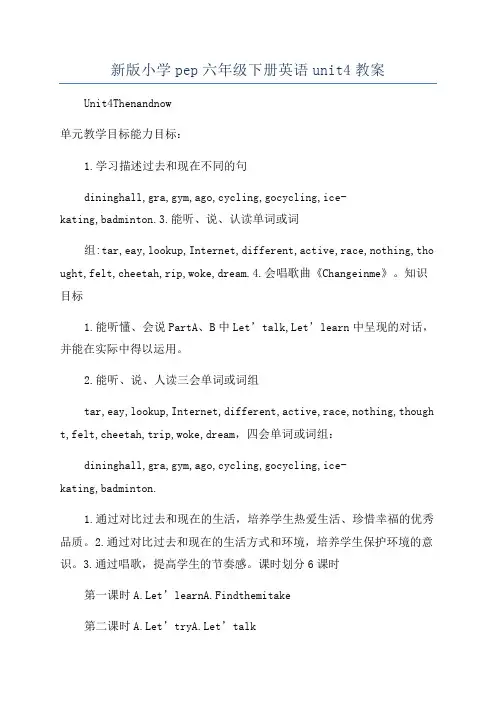
新版小学pep六年级下册英语unit4教案Unit4Thenandnow单元教学目标能力目标:1.学习描述过去和现在不同的句dininghall,gra,gym,ago,cycling,gocycling,ice-kating,badminton.3.能听、说、认读单词或词组:tar,eay,lookup,Internet,different,active,race,nothing,tho ught,felt,cheetah,rip,woke,dream.4.会唱歌曲《Changeinme》。
知识目标1.能听懂、会说PartA、B中Let’talk,Let’learn中呈现的对话,并能在实际中得以运用。
2.能听、说、人读三会单词或词组tar,eay,lookup,Internet,different,active,race,nothing,though t,felt,cheetah,trip,woke,dream,四会单词或词组:dininghall,gra,gym,ago,cycling,gocycling,ice-kating,badminton.1.通过对比过去和现在的生活,培养学生热爱生活、珍惜幸福的优秀品质。
2.通过对比过去和现在的生活方式和环境,培养学生保护环境的意识。
3.通过唱歌,提高学生的节奏感。
课时划分6课时第一课时A.Let’learnA.Findthemitake第二课时A.Let’tryA.Let’talk第三课时B.Let’learnB.L iten,match,anday第四课时B.Let’tryB.Let’talk第五课时B.Readandwrite第一课时ALet’learn&Findthemitake一、教学目标与要求:1.能够听、说、读、写以下七个单词和词组:dininghall,gra,gym,ago,year,month,lat。
2.能够正确运用上述七个单词和词组谈论或描述过去到现在发生的变化。
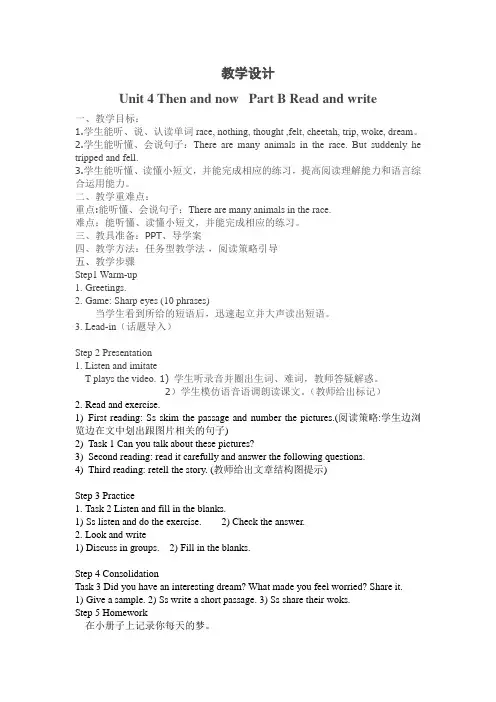
教学设计Unit 4 Then and now Part B Read and write一、教学目标:1.学生能听、说、认读单词race, nothing, thought ,felt, cheetah, trip, woke, dream。
2.学生能听懂、会说句子:There are many animals in the race. But suddenly he tripped and fell.3.学生能听懂、读懂小短文,并能完成相应的练习,提高阅读理解能力和语言综合运用能力。
二、教学重难点:重点:能听懂、会说句子:There are many animals in the race.难点:能听懂、读懂小短文,并能完成相应的练习。
三、教具准备:PPT、导学案四、教学方法:任务型教学法,阅读策略引导五、教学步骤Step1 Warm-up1.Greetings.2.Game: Sharp eyes (10 phrases)当学生看到所给的短语后,迅速起立并大声读出短语。
3.Lead-in(话题导入)Step 2 Presentation1.Listen and imitateT plays the video. 1) 学生听录音并圈出生词、难词,教师答疑解惑。
2)学生模仿语音语调朗读课文。
(教师给出标记)2.Read and exercise.1) First reading: Ss skim the passage and number the pictures.(阅读策略:学生边浏览边在文中划出跟图片相关的句子)2) Task 1 Can you talk about these pictures?3) Second reading: read it carefully and answer the following questions.4) Third reading: retell the story. (教师给出文章结构图提示)Step 3 Practice1.Task 2 Listen and fill in the blanks.1)Ss listen and do the exercise. 2) Check the answer.2.Look and write1)Discuss in groups. 2) Fill in the blanks.Step 4 ConsolidationTask 3 Did you have an interesting dream? What made you feel worried? Share it. 1)Give a sample. 2) Ss write a short passage. 3) Ss share their woks.Step 5 Homework在小册子上记录你每天的梦。
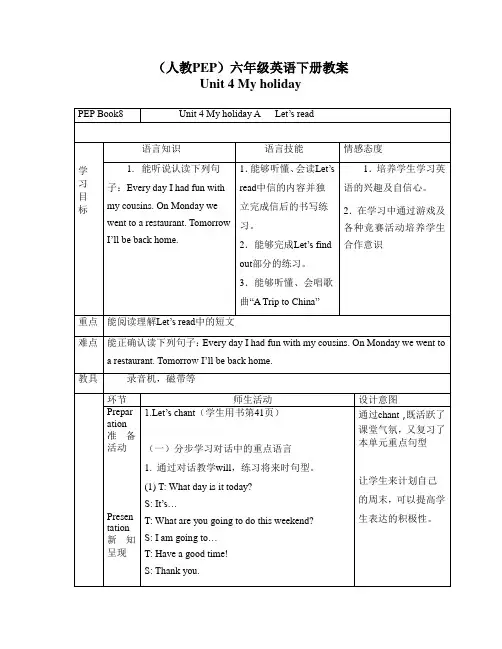
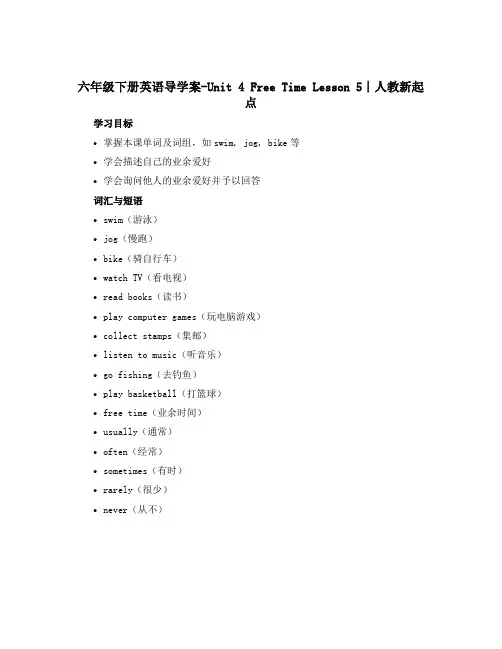
六年级下册英语导学案-Unit 4 Free Time Lesson 5∣人教新起点学习目标•掌握本课单词及词组,如swim, jog, bike等•学会描述自己的业余爱好•学会询问他人的业余爱好并予以回答词汇与短语•swim(游泳)•jog(慢跑)•bike(骑自行车)•watch TV(看电视)•read books(读书)•play computer games(玩电脑游戏)•collect stamps(集邮)•listen to music(听音乐)•go fishing(去钓鱼)•play basketball(打篮球)•free time(业余时间)•usually(通常)•often(经常)•sometimes(有时)•rarely(很少)•never(从不)课文内容Part 1Activity 1A:What do you do in your free time?B:I often swim and jog. What about you?A:I sometimes bike and watch TV.Activity 2A:What do you do on weekends, Tom?B:I usually read books and play computer games on weekends. What about you, Lucy?C:I often collect stamps and listen to music on weekends.Part 2Activity 1A:What do you do in your free time, Mike?B:I go fishing with my dad.Activity 2A:What do you do in your free time, Jack?B:I play basketball with my friends.习题1.根据课文内容,填空。
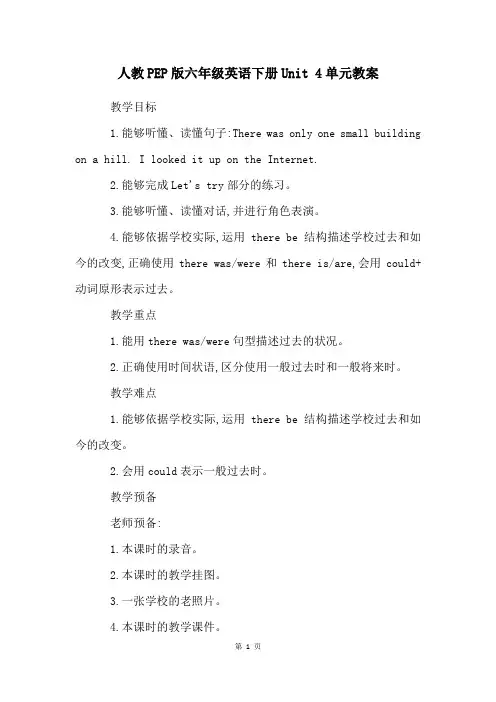
人教PEP版六年级英语下册Unit 4单元教案教学目标1.能够听懂、读懂句子:There was only one small building on a hill. I looked it up on the Internet.2.能够完成Let's try部分的练习。
3.能够听懂、读懂对话,并进行角色表演。
4.能够依据学校实际,运用there be 结构描述学校过去和如今的改变,正确使用there was/were和there is/are,会用could+动词原形表示过去。
教学重点1.能用there was/were句型描述过去的状况。
2.正确使用时间状语,区分使用一般过去时和一般将来时。
教学难点1.能够依据学校实际,运用there be 结构描述学校过去和如今的改变。
2.会用could表示一般过去时。
教学预备老师预备:1.本课时的录音。
2.本课时的教学挂图。
3.一张学校的老照片。
4.本课时的教学课件。
同学预备:1.水彩笔。
2.白纸。
教学方法1.角色表演教学法利用Let's talk 中的对话,同学分角色朗读对话。
在训练同学口语的同时,让同学娴熟把握there be 句型的一般过去时(表示过去存在)的用法。
2.情境教学法老师把以前的旧照片展现给同学,创设情景,让同学依据照片的内容用there was/there were 去描述,理解there was/there were 指过去某地有某物。
教学过程Step 1: Warmup1.老师热忱地和同学打招呼问好,做简洁的Free talk。
如: T: How was your weekend?S1: It was great.T: Where did you go last weekend?S1: I went to the zoo.T: What did you do there?S1: I saw many monkeys and took lots of pictures.2.老师播放四班级下册第一单元Let's sing—Our school,师生一起唱,创设气氛。
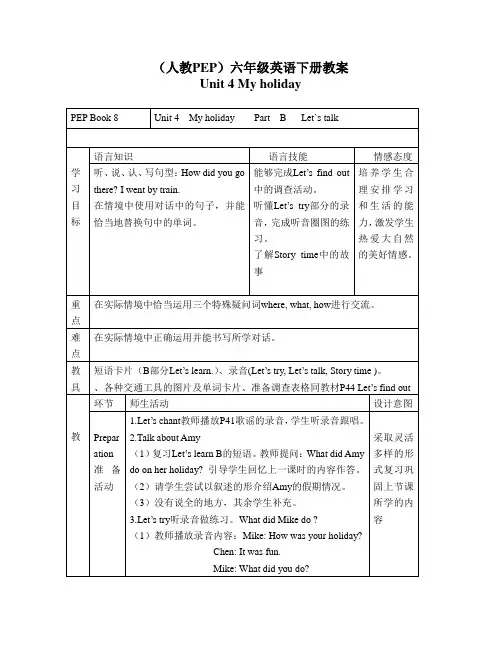
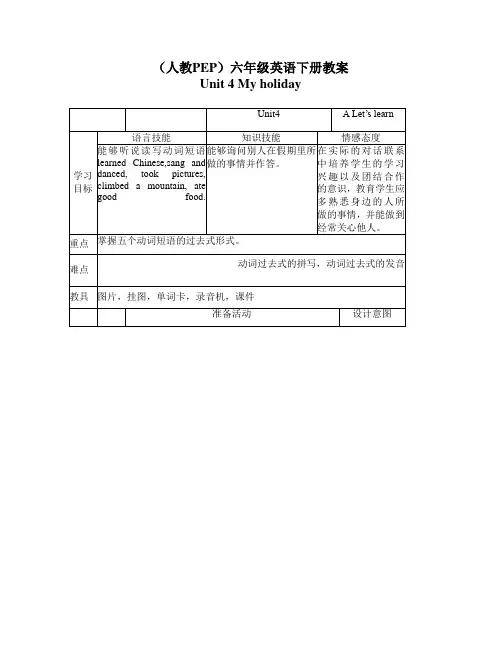
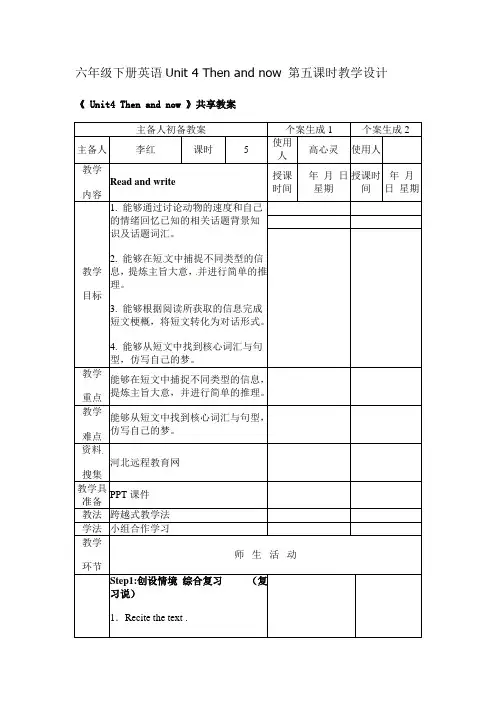
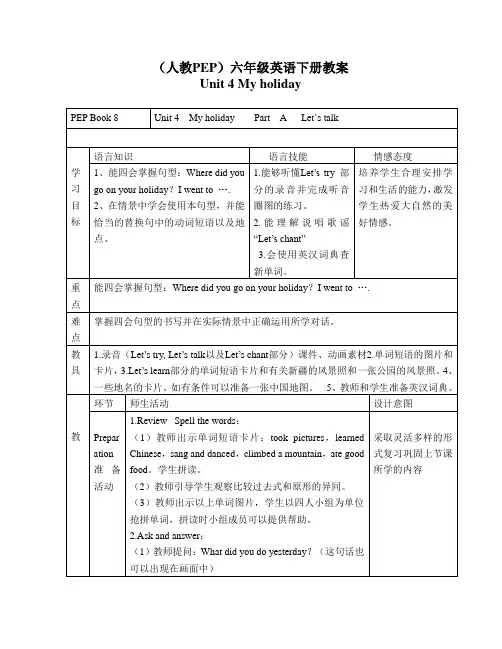
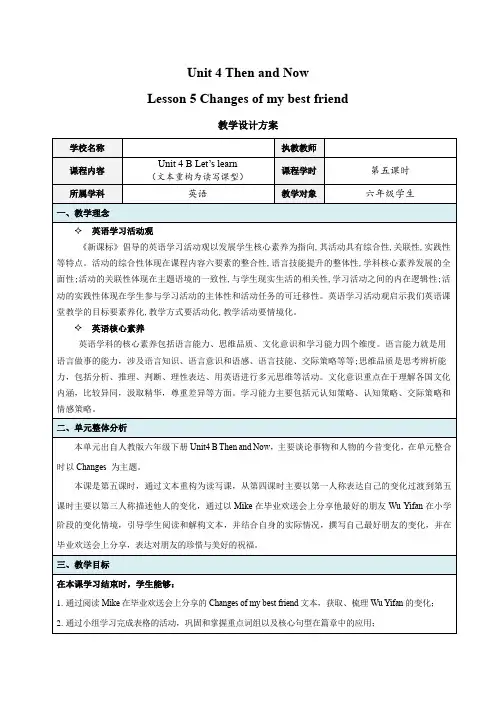
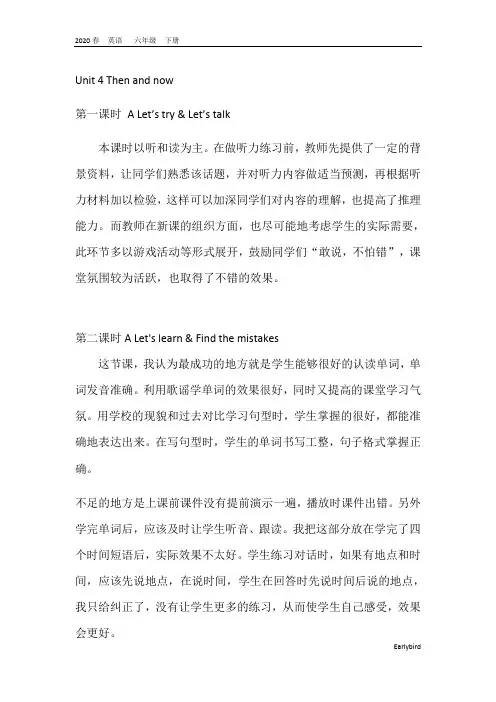
Unit 4 Then and now第一课时A Let’s try & Let’s talk本课时以听和读为主。
在做听力练习前,教师先提供了一定的背景资料,让同学们熟悉该话题,并对听力内容做适当预测,再根据听力材料加以检验,这样可以加深同学们对内容的理解,也提高了推理能力。
而教师在新课的组织方面,也尽可能地考虑学生的实际需要,此环节多以游戏活动等形式展开,鼓励同学们“敢说,不怕错”,课堂氛围较为活跃,也取得了不错的效果。
第二课时A Let's learn & Find the mistakes这节课,我认为最成功的地方就是学生能够很好的认读单词,单词发音准确。
利用歌谣学单词的效果很好,同时又提高的课堂学习气氛。
用学校的现貌和过去对比学习句型时,学生掌握的很好,都能准确地表达出来。
在写句型时,学生的单词书写工整,句子格式掌握正确。
不足的地方是上课前课件没有提前演示一遍,播放时课件出错。
另外学完单词后,应该及时让学生听音、跟读。
我把这部分放在学完了四个时间短语后,实际效果不太好。
学生练习对话时,如果有地点和时间,应该先说地点,在说时间,学生在回答时先说时间后说的地点,我只给纠正了,没有让学生更多的练习,从而使学生自己感受,效果会更好。
第三课时B Let’s try & Let’s talk本课时的设计注重同学们多听、多说。
教师要学习把“说话权”交给学生,让他们畅所欲言,在恰当的时候才纠正他们语言的错误,让他们放胆去说,克服羞于大声说英语的心理障碍。
同时联系生活实际,让同学们用所学句型描述自己的亲人,让他们在学习的同时亲近家人朋友,发挥自己的创造力。
第四课时B Let's learn Listen,Match and say本课时设计先是由生活实际引入,展开词汇教学,然后根据录音及多媒体设备等指导学生的“读”“说”能力,再接着采用多种游戏和交际性活动的形式巩固所学语言点,最后鼓励学生自我总结,从而取得较好的学习效果。
Unit 4 I have a pen pal A Let’s talk(教案)一、教学目标1.熟练掌握运用句型“I have a pen pal. She/He is from…”进行交流;2.能够使用My pen pal作文进行简短、清晰的介绍自己的笔友,并表达对笔友的喜爱之情;3.培养学生的语言表达能力和写作能力,培养合作精神和团队意识。
二、教学重点和难点1.教学重点:复习巩固“I have a pen pal”句型并能口头交流,能够使用My pen pal作文进行简短、清晰的介绍自己的笔友;2.教学难点:合理运用所学知识进行口语交流及书面表达。
三、学情分析学生学习英语的时间虽然不长,但是他们都对外界充满好奇,能够积极主动地表达自己,了解并学习外部世界。
因此,笔友这一话题可以引起学生浓厚的兴趣,加深他们对英语学习的关注和热情。
四、教学准备1.教师准备PPT;2.教师准备My pen pal的范文,向学生展示;3.准备黑板、彩笔、书本。
五、教学步骤Step1. 导入新课1.Greeting: 与学生问好并进行简单的打招呼;2.Song: 点播与笔友相关的英文儿歌,引发学生的兴趣。
Step2. 学术输入1.Watch the video about Tom’s pen pal:播放视频,了解Tom和他的笔友之间的日常交流;2.Learn the new words:教授与书信相关的单词,并让学生表演以加强记忆;3.Listen and repeat:通过Listen and Repeat练习,加强学生对单词的记忆。
Step3. 学科输出1.Follow the tape and chant together:带着学生一起朗读课文,并呈现课文的上下文信息;2.Pair work:学生以两人为一组,自由交换关于笔友的信息,运用所学语言表达情感;3.Group work:多人小组讨论并撰写My pen pal作文,并在班级中进行分享;4.Wrap-up: 教师对本堂课的内容进行复习和总结。
人教PEP版英语六年级下册Unit 4《Then and now》教案一. 教材分析人教PEP版英语六年级下册Unit 4《Then and now》主要让学生了解和掌握表示过去和现在的词汇,如“yesterday”, “today”, “tomorrow”等,并通过对比过去和现在的生活,让学生学会用英语表达自己的观点和感受。
本课时的重点是让学生能够熟练运用表示过去和现在的词汇描述图片,难点是正确运用一般过去时和现在时态。
二. 学情分析六年级的学生已经掌握了基本的英语语法和词汇,具备一定的听说读写能力。
但是,对于一般过去时和现在时态的运用还不够熟练,需要通过大量的练习来巩固。
此外,学生对于描述过去和现在的生活还存在一定的困难,需要教师通过实例和图片来引导和帮助。
三. 教学目标1.知识目标:学生能够掌握表示过去和现在的词汇,如“yesterday”,“today”, “tomorrow”等,并能够运用一般过去时和现在时态描述图片。
2.能力目标:学生能够通过听、说、读、写等多种方式,熟练运用表示过去和现在的词汇和时态,提高英语表达能力。
3.情感目标:学生能够通过对比过去和现在的生活,学会珍惜现在的生活,培养积极向上的生活态度。
四. 教学重难点1.重点:学生能够熟练运用表示过去和现在的词汇描述图片。
2.难点:学生能够正确运用一般过去时和现在时态。
五. 教学方法采用情境教学法、任务型教学法和分组合作学习法。
通过设定情境,让学生在实际语境中学习和运用表示过去和现在的词汇和时态;通过完成任务,让学生在实践中提高英语表达能力;通过分组合作学习,让学生在互动中交流和学习,提高团队合作能力。
六. 教学准备1.准备图片和图片描述卡片。
2.准备PPT,包括表示过去和现在的词汇和时态的例句。
3.准备练习题,包括选择题、填空题和句子完成题。
七. 教学过程1.导入(5分钟)通过展示两张图片,一张是过去的图片,一张是现在的图片,让学生猜测两张图片的拍摄时间,引导学生思考过去和现在的生活变化。
Unit4 my holiday第五课时教学设计一、教学设计思路本课时的主要教学内容是听、说、读、写句型:How did you go there? I went by…。
本课时中,教师可以首先以听和说引入,主要目的在于:一、回顾第四课时的主要内容,复习过去时;二、营造较轻松的语言环境,缓解部分学生对于读写的畏惧心理。
接下来,从看图说话引入Let’s try,给学生铺垫知识的过程。
然后,在学生通过Let’s try 初步了解本课时句型的基础上,教师仍然以上课时已经提到的哈尔滨作为话题引入本课时的对话教学。
最后,在story部分教师也是以看图和问题引入故事,在学生基本了解故事的基础上再进行阅读。
二、教学目标(一)知识听、说、读、写句型:How did you go there? I went by…。
了解story中的故事。
(二)能力能够在实际情景中正确运用并能书写所学对话。
(三)情感培养学生通过有趣故事了解中国古老传说的情感。
三、教学重难点重点:听、说、读、写句型:How did you go there? I went by…。
难点:在实际情景中正确运用并能书写所学对话。
四、教学媒体1.录音机及磁带。
2.有关哈尔滨的图片及第四课时中的短语图片。
3.教学课件。
4.有关嫦娥奔月的图片及资料;宇航员登月的资料。
五、教学过程1.导入1)Daily greeting2)教师播放第二课时中的chant,学生根录音齐唱。
3)教师出示哈尔滨图片,T: Where did I go last winter? Do you remember?…T: Yes. I went to Harbin. How did I go there? Guess?…让学生猜测各种交通工具后,T: I went there by train.T: Where did you go on your holiday?…T: How did you go there?…首先让学生在实际语言运用中了解本课时句型。
六年级下册英语教学设计-Unit 4 Free Time-人教新起点 (4)一、教学目标1.能听懂、会说、会读、会写以下单词和词组:swimming, skating, cycling, watching TV, playing the guitar, fishing, playing chess, playing cards, playing video games, playing computer games2.能听懂、会说、会读、会写以下句子:•What’s your hobby?•My hobby is swimming/cycling/skating/watching TV/playing theguitar/fishing.3.能掌握如何询问他人兴趣爱好,并能介绍自己的兴趣爱好。
二、教学内容1.英语单词:swimming, skating, cycling, watching TV, playing the guitar, fishing, playing chess, playing cards, playing video games, playing computer games2.英语句子:•What’s your hobby?•My hobby is swimming/cycling/skating/watching TV/playing theguitar/fishing.三、教学重难点1.英语单词和句子的掌握。
四、教学准备1.投影仪和计算机2.英语教材和课件3.英语单词和句子的练习卡片五、教学过程1. Warm-up教师通过展示一些图片或直接提问,与学生进行问答练习。
e.g.T: What’s your hobby?S1: My hobby is reading.T: What’s your favorite food?S2: My favorite food is pizza.2. Presentation教师以图片和示范的方式向学生展示新单词,并帮助学生逐步理解含义。
Unit4 my holiday
第五课时教学设计
一、教学设计思路
本课时的主要教学内容是听、说、读、写句型:How did you go there? I went by…。
本课时中,教师可以首先以听和说引入,主要目的在于:一、回顾第四课时的主要内容,复习过去时;
二、营造较轻松的语言环境,缓解部分学生对于读写的畏惧心理。
接下来,从看图说话引入Let’s try,给学生铺垫知识的过程。
然后,在学生通过Let’s try初步了解本课时句型的基础上,教师仍然以上课时已经提到的哈尔滨作为话题引入本课时的对话教学。
最后,在story部分教师也是以看图和问题引入故事,在学生基本了解故事的基础上再进行阅读。
二、教学目标
(一)知识
听、说、读、写句型:How did you go there? I went by…。
了解story中的故事。
(二)能力
能够在实际情景中正确运用并能书写所学对话。
(三)情感
培养学生通过有趣故事了解中国古老传说的情感。
三、教学重难点
重点:听、说、读、写句型:How did you go there? I went by…。
难点:在实际情景中正确运用并能书写所学对话。
四、教学媒体
1.录音机及磁带。
2.有关哈尔滨的图片及第四课时中的短语图片。
3.教学课件。
4.有关嫦娥奔月的图片及资料;宇航员登月的资料。
五、教学过程
1.导入
1)Daily greeting
2)教师播放第二课时中的chant,学生根录音齐唱。
3)教师出示哈尔滨图片,
T: Where did I go last winter? Do you remember?
…
T: Yes. I went to Harbin. How did I go there? Guess?
…
让学生猜测各种交通工具后,
T: I went there by train.
T: Where did you go on your holiday?
…
T: How did you go there?
…
首先让学生在实际语言运用中了解本课时句型。
2.呈现新课
1)Let’s try
T: Look at the first pictures. What did the girl do?
…
在分别让学生说一说第二、三幅图中的男孩、女孩分别在干什么。
教师播放录音,让学生听录音选择。
2)Let’s talk
T: Wh at’s the weather like in Harbin in winter?
教师引导学生说:It’s cold and snowing.
T: What can we do there in Harbin?
S: We can go skiing and ice-skating there.
T: Yes. We can go skiing and ice-skating there. How wonderful! I also can see many ice-sculptures there. Do you want to go?
Ss: Yes.
T: Ok. Let’s go. But how can we go there?
…
T: We can go there by train or plane. I went Harbin by train last winter.
教师在黑板上板书I went by train. 让学生跟读。
教师让学生推测如何就I went by train提问。
教师耐心听完学生们的推测后,
T: Ok, now listen.
教师播放Let’s talk部分录音,让学生检验自己的推测是否正确。
T: Where did Sarah go on her holiday?
S: She went to Harbin.
T: How did she go there?
S: She went by train.
教师板书How did she go there? 让学生跟读并进行书写。
T: What did she do there?
S: She went skiing.
教师让学生跟读两遍录音。
教师将学生分成四组,各组分别选择教师准备好的图片,根据图片先分别将时间、地点、交通工具、动词短语的过去式形式写下来。
然后编写对话并进行表演。
2)Let’s find out
教师请一名学生说出自己曾经去过的几个地方和所乘坐的交通工具,然后示范填写表格。
学生两人一组进行采访调查。
然后请几名学生汇报调查结果。
教师提醒学生所要练习的语言目标:
Where did you go on your holiday/ last winter…?
I went …
How did you go there?
I went by…
What did you do there?
…
3)Story time
教师向学生展示story time部分的挂图,先让学生对故事进行猜测。
Where did Zoom go?
How did he go there?
What did he see there?
What did he do there?
教师播放story部分的录音,让学生看图听录音,对故事进行理解。
教师和学生一起检验他们对上边问题的回答。
在学生理解故事后,
T: Is it a dream?
…
时间允许的话,教师可以让学生了解更多的有关嫦娥奔月的传说以及宇航员登月的史料。
3.趣味操练
1)将学生分组,就自己一次真实的外出活动编写为对话,并进行对话练习。
并将第二课时中的chant进行改编。
2)“快乐的一天”
教师让学生回忆六年小学生活中最快乐的一天,然后分小组讨论,各个小组分别写出那一天中的活动。
最后选一名代表进行汇报,看哪个小组记录的一天最有趣:
4.课堂评价
让学生完成本课时活动手册中的配套练习,评价学生对本课对话的掌握情况。
另外,评价体现在本课时教学的各个环节。
5.课后作业
让学生对自己的几个朋友进行采访,练习本课时句型,并制作表格(擦不找Let’s find out 表格)。